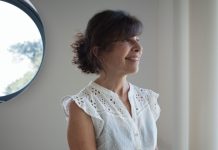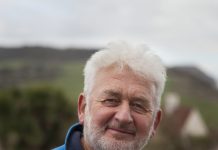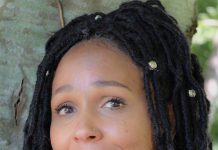Robin Mills met Julia Hailes at her home in Hooke, West Dorset.
‘My father was a prisoner of war, captured in Dunkirk at the age of 19. Apparently, he became expert at picking locks and tried to escape a few times, but he wouldn’t really tell us much about his five years in captivity. His army career continued after the war in Palestine, Malaya and Singapore, where he met my mother. Her route there was a rather surprising one, given that it wasn’t very common for women to travel the world on their own in those days. She’d stayed several months in South Africa before heading North through Uganda and Rhodesia, and finally arriving in Mombasa. It was there that fate intervened. She decided to catch the next ship, wherever it was going—and found herself on the way to the Far East.
It was a couple of years later that my father caused a crash in London, by jamming on the brakes of the car he was driving. He explained to the irate other driver that my mother had accepted his proposal to get married. They started their married life in Cyprus but then moved to Somerset—our family home was at Chiselborough, not far from Crewkerne. I’m the youngest of four—all born within 5 years of each other. Our home was always full of friends and I remember many days of BBQs, swimming and tennis, as well as lots of people getting roped into shelling peas or getting huge quantities of home grown vegetables into the freezer.
My memories of Knighton House boarding school, where I went at eight, are mixed. Playing hop-scotch, jacks, french elastic and winning tennis tournaments were highlights but getting hauled up in front of the whole school for putting disgusting spam and mashed potatoes in my pocket wasn’t such fun. And, I really missed home.
Soon after leaving school I spent a year in Paris—not ‘down and out’ but earning money from busking, selling flowers, and even one job which involved dressing up in silver foil to sell frying pans, and another making ‘pooper scooper’ gloves for Parisian poodles! When I returned to London my career was no less eclectic. I sold teddy bears in Selfridges, shirts and jumpers door to door, and spent a few months working as an industrial pudding cook for The Metal Box factory. One of my more entrepreneurial ventures involved inventing and developing magnetic L plates, before they were commercially available elsewhere.
My first ‘proper’ job was working in the information department at Leo Burnett advertising. It was tremendous training for my later career in terms of knowing how to track down useful information. I left to go travelling in South America. My friend and I arrived in Peru armed with the South American Handbook and two valuable Spanish sentences—‘Go away’ and ‘It’s too expensive’—both of which were very useful. But we did some pretty idiotic things—one of which was to sample every fruit that we’d never seen before, in the market of Arequipa. The night time train to Cuzco was spent being terribly sick through a hole in the floor as there weren’t any proper loos.
When my friend returned to the UK, I continued travelling. On one trip I stayed with a wealthy Spanish family who had servants serving their meals in clean white gloves, in the middle of the forests of Mato Grosso. Seeing the trees stretch into a hazy blue distance, I was captivated—but then horrified to see men with chainsaws hacking it down.
Back to London and after a few ventures, I took a job in TV production—making commercials and pop videos—even though I didn’t like my boss. This wasn’t such a good idea as I began to dread going to work in the morning. One day, when he turned on me, I told him to get lost—albeit in rather more forceful language. It couldn’t have been better timing. I’d planned a two week trip to New York with a girl friend and I ended up staying away for a year and a half, starting my adventures by crewing on yachts.
A night time sail from New York to Washington took us through one of the busiest shipping lanes in the world with me at the helm. When I heard a loud booming noise and saw flashing lights across the water, I woke the captain. In haste he threw us onto a different course and explained that I’d missed the navigational lights indicating we were on course towards a tow line between two barges, which could have destroyed us.
Later on we got caught in a hurricane in the Bermuda triangle. Whilst the two most experienced sailors argued over which was the ‘navigational side’ of the storm, I hooked myself onto the boat wires to stop getting swept overboard. In Antigua, I got a job on a luxury racing yacht serving drinks to Teddy Kennedy, amongst others. The most horrifying thing about this boat was that they chucked all their rubbish into the sea—including plastics. Then they’d complain about the litter on beaches. I got them to stop, and I hope they continued with the new regime when I jumped ship in Belize. It took several more months to get home, via Guatemala, Mexico, and through the States.
I got back in November and by the end of 1986 had found a job working with an environmental group called Earthlife. It was there that I met John Elkington, who became my business partner. We set up ‘SustainAbility’, the first campaigning consultancy of the time—and we wrote 8 books together. The most successful publication was The Green Consumer Guide, which came out in 1988. It had 11 print runs in the first few weeks and went on to sell over one million copies worldwide. John’s idea was that businesses would be more ‘green’ if they knew that it would bring them more customers, whilst I saw it from the other direction—if most people knew the environmental impacts of their shopping habits they’d make ‘greener’ choices.
What neither John nor I had anticipated was the response from the business world. As consultants, we were besieged by companies saying they recognized the importance of environmental issues, but what could they do. ICI, British Airways, Shell, and Proctor & Gamble were all clients. And, we got a lot of media coverage too, with centre page spreads in most of the national papers. I even got my own weekly TV series—a slot on the Richard & Judy show.
In 1994 I sold out of SustainAbility and moved back to Somerset, renting the National Trust property at Tintinhull. I was still working but having babies too—my youngest came to Buckingham Palace with me to accept an MBE from the Queen, for my environmental work. He was still breast feeding.
I’ve since re-married and moved to Dorset. The farmhouse we bought has become a passion. We started with minor alterations but, having found a brilliant Dorset builder, our vision has grown – landscaping, tree planting, orchards, developing out-houses, workshops, extra bedrooms and a large motor-bike storage area for my husband. One of the most challenging things is working out the best eco-renovations that can be done, and combining that with smart technology. And, I haven’t stopped campaigning—these days one of my top issues is reducing waste, whether it’s electronic goods or disposable paper napkins. But I’m also desperate to save the rainforests too.
When we’ve finished we’d like our home to become a sort of community with family, friends and space for people to work. In some ways, I will have come full circle – re-creating the home where I grew up.’









